Group Research Project: Make, Perform & Report
In this group project, we chose the story in “The Ones Who Walk Away From Omelas” by Ursula K LeGuin as our assigned criteria. The story was mainly about a city Omelas where everyone’s happiness and goodness is dependent on locking up a kid. The kid must be kept miserable so that the whole city can function well. So we came up with the idea to design a helmet which could help the kid ease the pain and get rid of the bad memories and sacrifices. At the same time, the helmet could show curve of the kid’s mood so that people can better get to know his mental situation. The sensors, chip and processor are the main parts of the helmet.
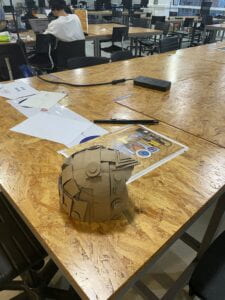
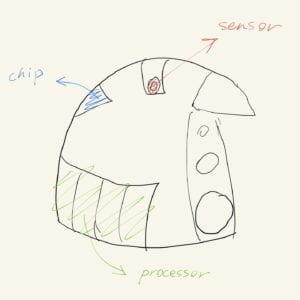
I think that we did a good job connecting the project with the fictional story, but the design can be more interesting and have more interaction function. If it’s not a helmet, but something we have never seen that can also interact with us, it would be a whole new interesting idea.
During the whole process of making this project, my group had a good time working together. We first choose an idea, which is the one we are using now from all the ideas we have come up with. Then we started brainstorming together to expand the idea and find a storyline and connection of it. After making the whole story, we knew what we need to build.
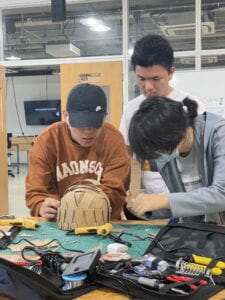
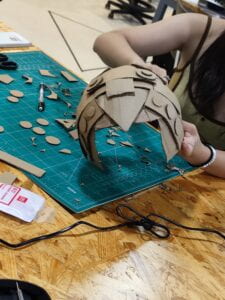
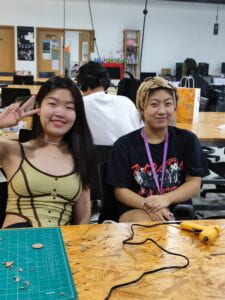
So we find an afternoon and build the helmet using cardboard in 826 together. After finishing building the prop, we wrote the script together while we were in rehearsal, and we practiced it together. My group did most of the work together, but there was still some division of work. For example, when building the helmet, me and Vicky did the decoration part while other teammates made the main body of the helmet. Also, every one of us wrote our own part of script so that we can remember it easily and better perform it. When doing all these, we mainly used wechat to communicate, because we have different schedules, so it was a bit hard for the five of us to meet, which means that sometimes only three of us meet and work together. But luckily we had a good communication and always help the teammates who wasn’t there to catch up with everything, everyone clearly knew what we were making and what we needed to do.
This is when we were in rehearsal ⬆️
When watching other groups’ performances, a group caught my attention. This group build a robot which can help people that are petrified to move or get food. The robot interacts with people by responding to their instructions and following them. This project is closely related to the fictional story The Plague by Yan Leisheng. I think his is super cool design, but it is also limited. For example, it can only identify some of people’s gestures and can’t fully understand everything people say so it might be hard to improve his service. Also, it’s very expensive to build a robot like this which serves a lot of patients every day. I think the performance was creative and the idea was wonderful, but the group can do more research and find out the workload of the robots and the affordability of the government, also, there can be more design of the robot’s ability, so that it can help petrified people more.
This is when we were performing ⬆️
Here’s the script of our performance:
Characters
Narrator: Tina
3 villagers: Calvin, Blake, Jack
Depressed Child: Vicky
Door: Blake, Jack
Patient: Vicky
Doctor: Calvin
Assistant: Blake
Technician: Jack
Brainwave Reader: Tina
Scene 1: Backstory
Narrator: Once upon a time, there was a utopia, and everyone in the city was so sad and so exhausted, just like you have just survived the midterm exam.
- Actions → villagers act sad (look down)
Narrator: One day, someone told them that if you want to exchange the goodness of everyone in the city, you need to lock a girl into a basement and give her no food, no light, and no care for five year.
- Actions → villager Calvin brings Depressed Child Vicky into the scene and both narrator and villager push her down to the floor (the basement)
- Actions → Depressed Child Vicky act depressed
Narrator: Now, five years later, she got rescued from the basement, but she’s still so depressed. So, someone developed a helmet to help her.
- Actions → Depressed Child Vicky gets up, villager Calvin puts helmet on her
Narrator: (to Depressed Child Vicky) How are you feeling now? Are you feeling better?
Depressed Child: Yeah, I feel happy. I can see the light. I can see the light ahead of me. It’s so bright.
Narrator: Are you feeling energetic now?
Depressed Child: I’m so energetic.
- Actions → Depressed Child Vicky jumps up and down
Narrator: Are you happy now?
Depressed Child: I’m so happy.Thank you!
- Actions → Depressed Child continue to jump
- Actions → Narrator and Child hug
Scene 2: Present day
- Actions → Patient walks through door
Doctor: Sorry madame, please stop. We are detecting severe negative energy from you. Please follow us to this room please.
- Actions → doctor stops patient at door, leads her to the room (the chairs)
- Actions → both doctor and patient sits down, assistant has the helmet in her hand, and technician is sat on a different chair on the side
Doctor: *Sighs* Can I see the notebook please?
Assistant: Yes.
- Actions → assistant passed notebook to doctor, doctor opens and look
Doctor: Yikes, another one affected by the Calculus quiz today. Must be traumatic for you.
Patient: Very.
Doctor: (to Assistant) Assistant, please put the helmet on her. (To Patient) Relax, it won’t hurt. Just let the energy come out of you. (To Technician). Everything’s set and connected?
- Actions: Assistant puts helmet on patient, Assistant puts Tina’s hand on Patient’s head/helmet
Technician: Yes.
- Actions → Tina starts drawing brain waves on white board
Doctor: (back to Patient) How are you feeling madame?
Patient: It’s not kicking in yet.
Doctor: Really?
Patient: Oh wait, I feel it.
Doctor: It takes a little bit.
Patient: Yea, it does. Oh, I feel it tingling. It’s like a massage. I think I’m not as depressed.
Doctor: Are you sure? I know the Calculus quiz was a bit rough for you guys today.
Patient: It was a bit rough, you know, front page blank, back page blank.
Doctor: It’s all good.
Patient: Yea, all good. Um, I think I’m good.
Doctor: Then, it’s all set. I think you’re stabilized now. (To assistant) Please take the helmet off of her please. (To patient) Go home safe, take some rest, don’t think about that quiz, it’s all over now.
Patient: I won’t, I won’t. Thank you so much.
Scene 3: Audience interaction
Assistant: (comes up to the doctor and whispers) There’s sad people in the audience.
Doctor: It seems like there are a lot of sad people in our audience today.
- Actions → turns to audience and pick out a random member and improv the helmet treatment
*The end*
Leave a Reply